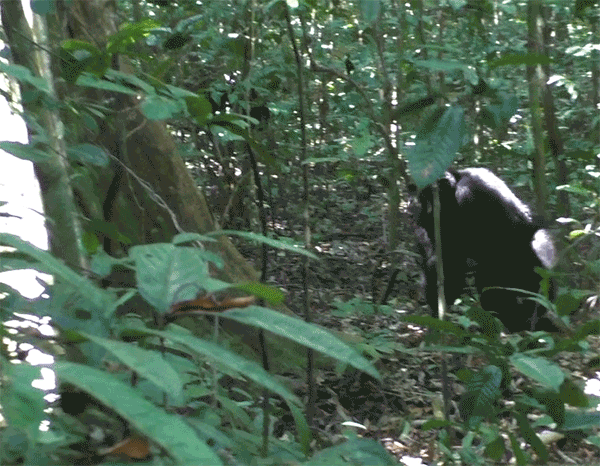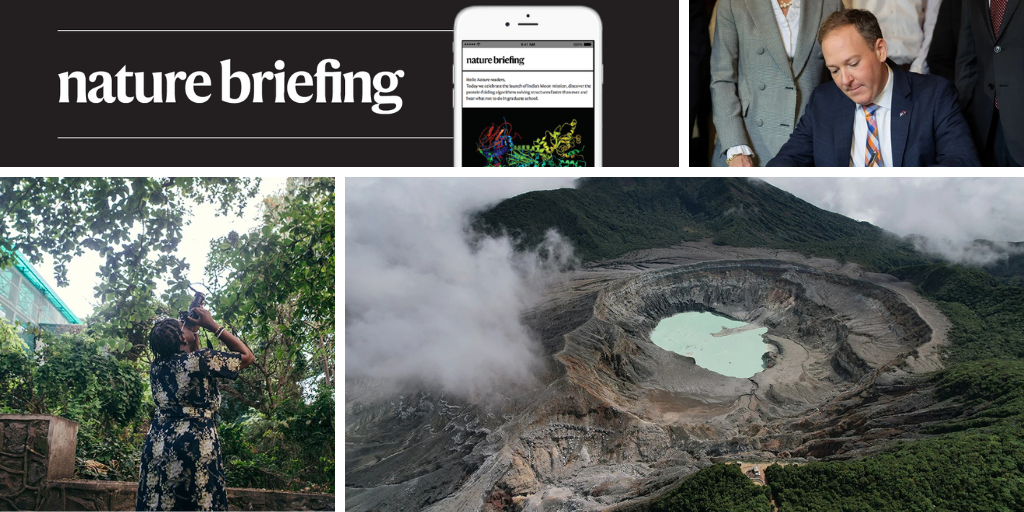You have full access to this article via your institution.
Hello Nature readers, would you like to get this Briefing in your inbox free every day? Sign up here.

Wild chimpanzees — such as this western chimp jamming in the Ivory Coast — use rhythmic drumming patterns that vary across populations, indicating the richness of subspecies and cultural differences. (Eleuteri et al./Current Biology)
Wild chimpanzees drum on tree roots in specific rhythms to communicate across long distances. These rhythms differ between populations — western chimps (Pan troglodytes verus) thump in evenly spaced beats, while their eastern counterparts (Pan troglodytes schweinfurthii) take alternating long and short pauses after beats. A separate study explored how Western chimps drum by throwing stones against trees. Researchers suggest the behaviours are influenced by the social dynamics of the animals’ groups, and could hint at the evolutionary origins of musicality.
Reference: Current Biology paper & Biology Letters paper
Google says that an upgraded version of its medical chatbot can use smartphone photos to diagnose rashes and evaluate a host of other medical imagery. And the system — called the Articulate Medical Intelligence Explorer (AMIE) — reportedly gave more accurate diagnoses than did human physicians when shown images such as electrocardiograms and PDFs of laboratory results in simulated medical scenarios. AMIE is still purely experimental, but “brings us closer to an AI assistant that mirrors how a clinician actually thinks”, says epidemiologist Eleni Linos. However, “there’s a lot of uncertainty about how it would be helpful”, says digital-health specialist Dan Zeltzer, who also notes that the preprint did not reveal the code or prompts.
Reference: arXiv preprint (not peer reviewed)
The main science division of the US Environmental Protection Agency (EPA) is being de-facto shut down, say insiders — despite the agency’s public denials. The Office of Research and Development (ORD) carries out research in support of environmental laws and regulations, such as assessing the safety of chemicals in drinking water. “They have basically shut ORD down by cutting off the money,” says Jennifer Orme-Zavaleta, who served as principal deputy assistant administrator at the ORD during the first administration of US president Donald Trump.
The situation at the EPA is among the most pronounced examples of an approach, spearheaded by billionaire Elon Musk’s DOGE task force, that is hobbling activities across several US federal agencies including the National Oceanic and Atmospheric Administration. “This makes sense if you assume that the purpose of DOGE is not to make government work better,” says public-policy researcher Donald Moynihan , “but to stop government from working at all.”
Nature | 6 min read & The Washington Post | 6 min read
Features & opinion
Geomicrobiologist Karen Lloyd’s Intraterrestrials offers readers a whistle-stop tour of the hardiest microorganisms on Earth. The book reports from the front lines of microbial research in some of Earth’s most extreme environmental conditions, from the deep ocean crust to the hearts of volcanoes, and explores how these discoveries might help the hunt for life on other worlds. “An unusual page-turner”, writes microbial ecologist Andreas Teske in his review, it’s “required reading for anyone who is interested in how the microbial world and our home planet have shaped each other”.
The effects of trauma can ripple across generations, but most work in the field focuses on individuals, analysing symptoms such as the biological markers of stress. This risks missing out on the full community and cultural context, argues Cindy Sangalang, a researcher of social welfare and ethnic studies. “Think of a child who has the devastating experience of losing a parent,” she posits. What if the event happened as a result of persistent local violence, or at the hands of state authorities? “An understanding of the child’s trauma is important to help them,” writes Sangalang. “But a broader understanding of how the community’s history shaped the neighbourhood can reveal larger-scale opportunities to prevent such harm in future.”
The DNA of each child contains mutations not found in either of their parents. To find out how much DNA changes, and how fast the human genome mutates, researchers compared the genomes from four generations of a single family. They found mutation hotspots and bigger genetic changes than had been seen before.
Last week, Leif Penguinson was exploring a dry river bed in the vast woodlands of Pilliga Nature Reserve in Australia. Did you find the penguin? When you’re ready, here’s the answer.
Thanks for reading,
Flora Graham, senior editor, Nature Briefing
With contributions by Jacob Smith
Want more? Sign up to our other free Nature Briefing newsletters:
• Nature Briefing: Careers — insights, advice and award-winning journalism to help you optimize your working life
• Nature Briefing: Microbiology — the most abundant living entities on our planet — microorganisms — and the role they play in health, the environment and food systems
• Nature Briefing: Anthropocene — climate change, biodiversity, sustainability and geoengineering
• Nature Briefing: AI & Robotics — 100% written by humans, of course
• Nature Briefing: Cancer — a weekly newsletter written with cancer researchers in mind
• Nature Briefing: Translational Research — covers biotechnology, drug discovery and pharma


